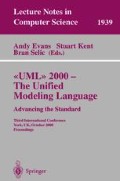Abstract
The UML has been widely accepted as a standard for modeling software systems and is supported by a great number of CASE tools. However, UML tools often provide only little support for validating models early during the design stage. Also, there is generally no substantial support for constraints written in the Object Constraint Language (OCL). We present an approach for the validation of UML models and OCL constraints that is based on animation. The USE tool (UML-based Specification Environment) supports developers in this process. It has an animator for simulating UML models and an OCL interpreter for constraint checking. Snapshots of a running system can be created, inspected, and checked for conformance with the model. As a special case study, we have applied the tool to parts of the UML 1.3 metamodel and its well-formedness rules. The tool enabled a thorough and systematic check of the OCL well-formedness rules in the UML standard.
Access this chapter
Tax calculation will be finalised at checkout
Purchases are for personal use only
Preview
Unable to display preview. Download preview PDF.
References
Tony Clark, Stuart Kent, Jos Warmer, et al. OCL Semantics FAQ, Workshop on the Object Constraint Language (OCL) Computing Laboratory, University of Kent, Canterbury, UK. Internet: http://www.cs.ukc.ac.uk/research/sse/oclws2k/index.html, March 2000.
Andy Evans and Stuart Kent. Core meta-modelling semantics of UML: The pUML approach. In Robert France and Bernhard Rumpe, editors, UML’99-The Unified Modeling Language. Beyond the Standard. Second International Conference, Fort Collins, CO, USA, October 28-30. 1999, Proceedings, volume 1723 of LNCS, pages 140–155. Springer, 1999.
Frank Finger. Design and implementation of a modular OCL compiler. Diplomarbeit, Dresden University of Technology, Department of Computer Science, Software Engineering Group, Germany, March 2000.
Daniel Jackson, Ian Schechter, and Ilya Shlyakhter. Alcoa: the Alloy constraint analyzer. In Proc. International Conference on Software Engineering, Limerick, Ireland, June 2000, 2000. (to appear).
Luis Mandel and María Victoria Cengarle. On the expressive power of OCL. In FM’99-Formal Methods. World Congress on Formal Methods in the Development of Computing Systems, Toulouse, France, September 1999. Proceedings, Volume I, volume 1708 of LNCS, pages 854–874. Springer, 1999.
Darmalingum Muthiayen. Real-Time Reactive System Development — A Formal Approach Based on UML and PVS. PhD thesis, Department of Computer Science at Concordia University, Montreal, Canada, January 2000.
OMG. Object Constraint Language Specification. In OMG Unified Modeling Language Specification, Version 1.3, June 1999 [9], chapter 7.
OMG, editor. OMG Unified Modeling Language Specification, Version 1.3, June 1999. Object Management Group, Inc., Framingham, Mass., Internet: http://www.omg.org, 1999.
OMG. UML Semantics. In OMG Unified Modeling Language Specification, Version 1.3, June 1999 [9], chapter 2.
Mark Richters and Martin Gogolla. On formalizing the UML Object Constraint Language OCL. In Tok Wang Ling, Sudha Ram, and Mong Li Lee, editors, Proc. 17th Int. Conf. Conceptual Modeling (ER’98), volume 1507 of LNCS, pages 449–464. Springer, 1998.
Mark Richters and Martin Gogolla. A metamodel for OCL. In Robert France and Bernhard Rumpe, editors, UML’99 — The Unified Modeling Language. Beyond the Standard. Second International Conference, Fort Collins, CO, USA, October 28-30. 1999, Proceedings, volume 1723 of LNCS, pages 156–171. Springer, 1999.
Jos Warmer and Anneke Kleppe. The Object Constraint Language: Precise Modeling with UML. Addison-Wesley, 1998.
Author information
Authors and Affiliations
Editor information
Editors and Affiliations
Rights and permissions
Copyright information
© 2000 Springer-Verlag Berlin Heidelberg
About this paper
Cite this paper
Richters, M., Gogolla, M. (2000). Validating UML Models and OCL Constraints. In: Evans, A., Kent, S., Selic, B. (eds) ≪UML≫ 2000 — The Unified Modeling Language. UML 2000. Lecture Notes in Computer Science, vol 1939. Springer, Berlin, Heidelberg. https://doi.org/10.1007/3-540-40011-7_19
Download citation
DOI: https://doi.org/10.1007/3-540-40011-7_19
Published:
Publisher Name: Springer, Berlin, Heidelberg
Print ISBN: 978-3-540-41133-8
Online ISBN: 978-3-540-40011-0
eBook Packages: Springer Book Archive

